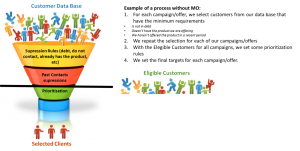In this journey to direct marketing optimization, we have already gone through two important concepts: understanding what optimization means and differentiating customers through analytics for optimization.
It is now time to make a stop to think about the campaign design process. We will describe how we need to plan our marketing activities in order to make the most out of the optimization process.
Typical Target Selection Process
In order to select the targets for campaigns, most companies use campaign management solutions. In this kind of solutions, users can build campaign decision flows to select those customers that are eligible for a certain offer. The decision flows will typically have several selection rules to check basic descriptive variables like gender, product holding, city, segment, etc. More analytical driven companies will also use predictive scores in order to select the best customers for their campaigns.
Another important selection filter is to check contact policy rules. Customers that have already been contacted last month with a similar offer might not want to be bothered with the same offer, so they are not included in the target selection.
During any given month, companies can run dozens or even hundreds of campaigns. As a result, a customer can be selected for more than one campaign. In order to solve this issue, companies usually include prioritization filters in their campaign flows. By doing this, they select a unique offer for each customer. As these rules are part of the decision flows in the campaigns, the targets are already unique and there is no room for optimization.
Setting the Eligible Universe
One of the premises in Marketing Optimization is that there are customers that are eligible for more than one campaign and we cannot offer all of them due to different restrictions.
The word eligible is very important in the formulation of an optimization scenario. Only customers that meet the basic requirements for campaigns (eligibility) should be included in the optimization exercise. It is very important to set these basic requirements or filters. For example if our contact policy is not to contact a customer that has already been contacted last month, then this customer is not eligible for any campaign and cannot be part of the eligible universe. However if we would like to understand how our optimized result might change if we include them, then we need to incorporate these customers in the optimization exercise. The same criteria applies to customers with high risk profiles, with high probability of churn, etc.
As most companies have automatic prioritization processes in place that control the customers that are assigned to each campaign, thinking about the eligible universe is not always straightforward. It implies thinking about rules we would like to challenge and then making the changes in the automated process already in place.
Campaign Planning
Another important aspect of campaign design for optimization is planning. We have worked with many customers and we have found there are different approaches. In some companies, 80% of the campaigns are planned at the beginning of the month. During the rest of the month, some extra marketing campaigns are run, but the majority of the activities occur as planned. In other companies, where the marketing dynamic is not that controlled, most campaigns are not planned and targets are selected ad-hoc as requested by product or segment managers.
When optimizing, planning is very important. By planning the campaigns that are going to be delivered during certain period, we can select all the eligible customers at once and run the optimization scenarios with all the possible targets. Most often, the optimization period is monthly or bi weekly. For example if the optimization is done monthly, at the beginning of each month the campaign designers can select the targets, build the eligible universe, evaluate different scenarios and set which customer receives which offer. If there is no planning and campaigns are delivered just as they come, a customer that could have been selected for a more profitable campaign might be selected for an earlier campaign that month. This would be more likely to be a prioritization exercise than an optimization one.
As you can see, the optimization journey is a very exciting one. It's full of adventures and new discoveries. Our next stop in is the land of objectives. We will explore what our goals should be when optimizing direct marketing campaigns and which data we need to collect in order to set clear objectives. Stay tuned for our next stop on our journey - same time, same place next week.
Editor’s note:
If you did not read the previous posts in this series, I encourage you to do so since Luciana planned them as a step-by-step journey. Marketing optimization is a very effective way to tie overall business objectives (often profitability) to marketing campaign activity because it mathematically calculates the best aggregate outcomes based on how you define them. If you'd like to dig a little deeper into how marketing optimization could work for you, I suggest you download this whitepaper, Improving Multichannel Marketing with Optimization. Among other useful content, it includes a practical checklist of seven steps to optimize your marketing.
